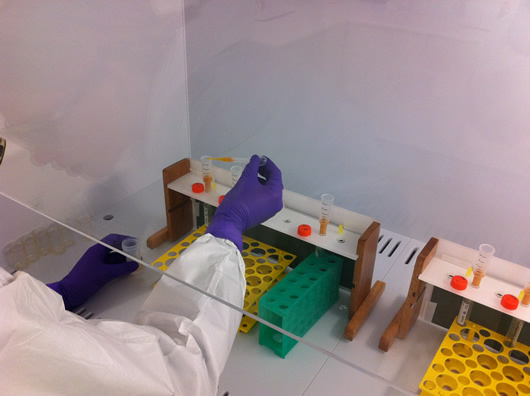WIGL News & Events - 2014
Seminar – Dr Fiona Larner (Oxford University) – 10 October 2014
Dr Fional Larner from Oxford University gave a seminar entitled “Isotope Biochemistry – Geochemistry’s emerging medical frontier”.
Many thanks to SMAH Research and GeoQuEST for supporting Dr Larner’s visit.
WIGL researchers date rock art among the oldest in the world – 09 October 2014
Max Aubert and Anthony Dosseto, with colleagues from the National Centre for Archaeology in Indonesia and the Centre for Archaeological Sciences (University of Wollongong), have dated rock art from Sulawesi to be ~40,000 years old. This has profound implications for our understanding of human evolution. Rock art is an illustration that people who produced it have developed an abstract mind, the capacities to model in their brain the world they saw around them. Thus, this is a sign of the latest stages of human evolution. Until now, the oldest rock art was found in Europe, suggesting this sort of artistic behaviour first appeared there. However, with the new findings, it shows that at the very same time, people in Europe and Indonesia were producing cave paintings.
The work was published in this week's issue of the scientific journal Nature.
UOW media release
Coverage by the Deutsche Welle
SBS podcast
One of the several interviews Anthony gave for the BBC Radio.

Hand stencils and a babi rusa (‘pig-deer’) at Leang Pettakere

The landscape of the Maros region where the paintings were found: rivers have carved through the limestone, and a flourishing agriculture takes place in the valleys. In the remnant limestone towers and plateau, countless caves can be found and in many, rock art is displayed.
Postgraduate student retreat - July 2014
Watch Leo Rothacker summarise his PhD project in under 3 minutes.
Preparation of the first batch of samples completed for cosmogenic 10Be – 22 July 2014
A few weeks ago, Reka was processing blanks which allowed us to show that the lab is clean enough to do in-situ cosmogenic isotopes. Today, Eleanor is completing the preparation of the first batch of samples fully processed in our lab for cosmogenic 10Be. Aliquots of these samples were previously prepared and analysed in another lab. This is the final step to fully validate the 10Be protocol.
In-situ cosmogenic 10Be has revolutionised the field of geomorphology over the past twenty years, allowing us to determine quantitative constraints on geomorphic processes (soil production and erosion rates, surface exposure dating, …). This is the first milestone of many coming years of exciting research at WIGL!
Many thanks to Reka and Eleanor for their hard work.


Anthony Dosseto gives a seminar at Sydney University – 21 May 2014
EarthByte and the School of Geosciences at Sydney University have invited Tony to give a seminar entitled “Earth’s thermostat: the role of chemical weathering and the climate feedback”. See for yourself below.
New publication in Nature Communications – 09 May 2014
Congratulations to John Jansen and Tibi Codilean for their paper in Nature Communications: “Inner gorges cut by subglacial meltwater during Fennoscandian ice sheet decay”. Check it out here: http://www.nature.com/ncomms/2014/140509/ncomms4815/full/ncomms4815.html